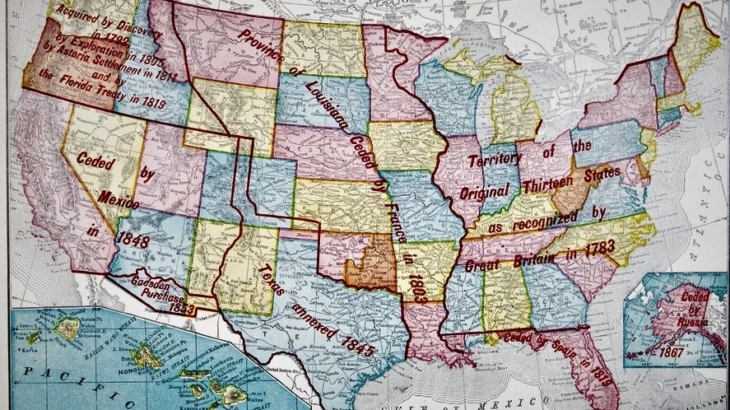April 30, 1803: The Louisiana Purchase Treaty Was Signed in Paris, Growing the United States
The 1803 treaty signed in Paris brought a purchase by the United States for 828,000 square miles, doubling the nation’s size. Constitutional questions stirred disputes over how to best divide territory and keep the nation’s peace. Concurrently, the Louisiana Purchase helped sustain America’s growing need for agriculture, free flow of commerce along the Mississippi, and secure westward regions.
On June 12, 1823, Thomas Jefferson wrote in a letter to William Johnson: “On every question of construction, let us carry ourselves back to the time when the Constitution was adopted, recollect the spirit manifested in the debates, and instead of trying what meaning may be squeezed out of the text, or invented against it, conform to the probable one in which it was passed.”
Twenty years earlier, Jefferson had been in a bit of a quandary concerning this very topic. As the third President of the United States, he was presented with an enormous opportunity: nearly double the size of the nation by purchasing land offered by France at a bargain-basement price. But search the Constitution from top to bottom, side to side, Article 1 to Amendment 11, he could find no explicit power given the President to make such a purchase. At first blush, Jefferson concluded an amendment to the Constitution was required. In an August 1803 letter to John Dickinson, he wrote: “The General Government has no powers but such as the Constitution gives it. It has not given it power of holding foreign territory, and still less of incorporating it into the Union. An amendment of the Constitution seems necessary for this.”
An amendment would have to be rushed through Congress. Jefferson’s Democratic-Republicans were tantalizingly close to the 2/3 majority needed to pass an amendment in the House (they controlled 67 of 103 seats, or 65%), but they only held 14 of 32 seats in the Senate (43%). The Federalists, still smarting from the drumming they took at the polls in 1800, were not at all interested in supporting Jefferson (sort of like today’s Democratic Party with President Donald Trump), so crossover votes were unlikely. Even if an amendment could get through Congress, it would take months to be ratified by the states; by then would this “deal of a lifetime” slip through their grasp? Would Napoleon Bonaparte have found another buyer? Otherwise, would Jefferson be required to “squeeze” new meaning out of the Constitution? The President could not pass this deal up, but what was he to do?
The ownership of the land was even in question. Totaling 828,000 square miles (530,000,000 acres) the land had been claimed at times by Britain, France and Spain. Its ownership in 1803 rested upon secret treaties and informal agreements. Everyone at the time could see that many states would eventually emerge from the acquisition (fifteen states to be precise) but to take control of both banks of the Mississippi, a river down which, to use Jefferson’s characterization “three-eighths of our territory must pass to market”[i] simply could not be passed up.
To solve his puzzle, Jefferson did the most practical thing he could think of. He consulted none other than “Father of the Constitution” himself, James Madison. Fortunately for the President, Madison worked right down the street from the “President’s House.”[ii] Jefferson had wisely brought Madison into the administration as his Secretary of State.
Madison adroitly opined that the power of a nation to “extend its territories” was a power enjoyed by any nation “by treaties.” And the treaty power was, without question, enjoyed by the President of the United States.[iii]
James Monroe and Robert Livingston had previously been dispatched to France to negotiate the purchase of New Orleans and Florida. The day after Monroe arrived in France (Livingston was already there) the pair had been summoned to the chambers of Talleyrand himself and offered the entirety of Louisiana. Unbeknownst to them, the day before, Napoleon had declared Louisiana “entirely lost” and ordered it be offered to the Americans. Napoleon needed the cash for yet another war with Britain. After some crafty negotiations, Monroe and Livingston were able to get the price down to $15 Million, still above the limits of their instructions, but “affordable.” The pair quickly signed the Louisiana Purchase Treaty on April 30th 1803, and hurried home.
On October 31, 1803, the last day the Senate could do so without nullifying it, the treaty was ratified, making Louisiana part of the United States.
Twenty-five years later, the Supreme Court would finally confirm Jefferson and Madison’s decision by stating: “The Constitution confers absolutely on the government of the Union, the powers of making war, and of making treaties; consequently, that government possesses the power of acquiring territory, either by conquest or by treaty.”[iv]
Gary Porter is Executive Director of the Constitution Leadership Initiative (CLI), a project to promote a better understanding of the U.S. Constitution by the American people. CLI provides seminars on the Constitution, including one for young people utilizing “Our Constitution Rocks” as the text. Gary presents talks on various Constitutional topics, writes periodic essays published on several different websites, and appears in period costume as James Madison, explaining to public and private school students “his” (i.e., Madison’s) role in the creation of the Bill of Rights and the Constitution. Gary can be reached at gary@constitutionleadership.org, on Facebook or Twitter (@constitutionled).
Click Here to have the NEWEST essay in this study emailed to your inbox every day!
Click Here to view the schedule of topics in our 90-Day Study on American History.
[i] April 18, 1802 letter to Robert Livingston.
[ii] The building would not be informally called the “White House” until shortly before the War of 1812 and not officially until action taken by President Theodore Roosevelt in 1901.
[iii] Article 2, Section 2.
[iv] American Insurance Co. v. Canter (1828).




Join the discussion! Post your comments below.
Your feedback and insights are welcome.Feel free to contribute!